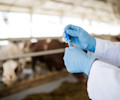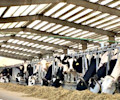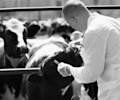Factory farming presents an array of issues for sustainable development, but what makes it unviable for long-term growth? Are you aware of the investment opportunities in the alternative proteins space? And what is the link between pensions and climate change?
To answer these questions and more, our Founder and CIO of Coller Capital, Jeremy Coller, gives a Sustainable Finance Masterclass in partnership with the WWF film, Our Planet: Too Big to Fail.
1) Why are pension funds so important?
Pension funds are among the largest pools of capital in the world. In 2019, pension funds held a combined total of $32.3 trillion in OECD countries. Having such a vast amount of assets under management means that pension funds are in a position to prop up harmful industries in the pursuit of short-term financial gains. It is, therefore, beneficial to choose a pension that focuses on sustainable investments, accounting for environmental, social, and governance (ESG) risk factors like greenhouse gas (GHG) emissions and deforestation. By contributing to a pension, we protect our own futures, but that future will only be worth protecting if ecosystems are maintained and the climate crisis is addressed.
In the last 15 years, pension funds have realised that sustainability is good business. The material risks that stem from climate change, biodiversity loss and human rights abuses are starting to draw attention from large firms.
2) Why is factory farming unsustainable?
Intensive animal farming is a highly risk-laden industry. Below, we outline four of the most material risks for investors:
Animal agriculture is the number 1 user of antibiotics worldwide, with these drugs often being used for prophylactic or growth promotion purposes, given to healthy animals often in place of good animal welfare practices. If this does not change, antimicrobial resistance could cost the world $100 trillion in global economic losses by 2050 (World Bank ref).
Of all the global anthropogenic GHG emissions, 14.5% come from animal agriculture. Reducing Scope 1, 2 and 3 emissions from factory farming will be key to preventing global temperatures rising above 1.5°C.
As an industry that is set to be impacted in myriad ways by climate change, the intensive livestock sector carries major food security risks. As demand for protein continues to grow, so too does the challenge of sustainably feeding a growing population.
Animal protein production is a drain on our natural resources. Livestock farming is the single largest driver of deforestation. In some cases, animal protein demands up to six times more water than plant-based proteins.
3) What are the investment risks around factory farming?
Investors should carefully consider the risks when building their portfolios, and factory farming poses some pretty significant risks. The growth of the alternative milk market, for example, shows how animal protein producers are losing out following advancements in plant-based protein production. Two major US dairy producers, Dean Foods Co. and Borden Dairy Co., filed for bankruptcy in November 2019 and January 2020 respectively, citing a decline in dairy consumption alongside rising demand for non-dairy alternatives (Appetite for Disruption: A Second Serving, 2020, pg. 8).
Reputational risks also arise from neglecting risk factors like labour rights and environmental degradation. Issues emerging from factory farming, such as antimicrobial resistance (AMR), put both companies and investors at risk of being affected by regulatory change.
4) What are the investment opportunities in alternative protein production?
From 2016 to 2020, demand for plant-based alternatives rose by 23%. This innovative sector poses a variety of opportunities for investors. The global protein market is valued at around $1.5 trillion and while alternative proteins only represent 1% of that, they are projected to make up 3% of the market by 2025 and 60% by 2040.
Major plant-based players, such as Oatly, show the real potential for growth in this sector. In 2019, it had revenue of $200 million and was reportedly seeking a valuation of $10 billion ahead of its much-anticipated IPO in 2021.
5) How does FAIRR use its influence to bring about change?
The FAIRR Initiative works with companies and investors to drive change while safeguarding the long-term value of their investment portfolios. Our collaborative engagements encourage major food companies to make commitments and take action in addressing the most material ESG risks in their supply chains.
Below are three examples of how we have changed the conversation and brought about change:
In 2016, FAIRR engaged with 20 restaurant chains on the overuse of antibiotics. At the start of the engagement, only one company had a policy on antibiotic usage. As of 2021, all 20 companies have a clear policy on antibiotic usage and have committed to addressing the overuse of these drugs in their supply chains.
We have been working with global food companies and 58 investors, which collectively represent $8 trillion in AUM, to find solutions to soy-related deforestation in the Cerrado. Companies, including Tesco, Nutreco and Greig Seafood, contribute to ‘The Funding Coalition’ to incentivise farmers to transition to soy that is produced exclusively on existing agricultural land.
Our Sustainable Proteins engagement, which has the support of 104 investors representing $16.6 trillion in AUM, aims to diversify protein sources away from an over-reliance on animal proteins. Of the 25 companies targeted by the engagement, 23 have improved their overall since 2019. This includes greater scope 3 emission disclosure and better data collection on diversified protein exposure.
Of course, these achievements are made possible without the ongoing collaboration of concerned parties. As well as facilitating key dialogues, we also help close the gap between investors, food companies, and protein producers. The influence that investors have in this respect should not be underestimated.
FAIRR insights are written by FAIRR team members and occasionally co-authored with guest contributors. The authors write in their individual capacity and do not necessarily represent the FAIRR view.











